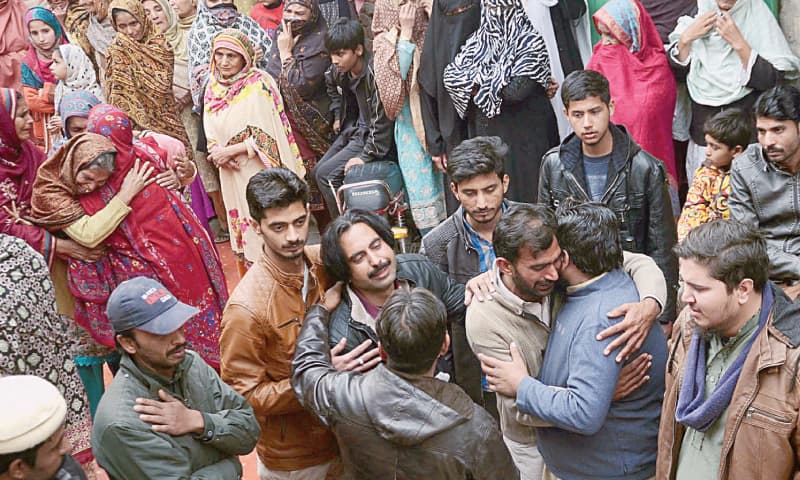What the Sahiwal shooting tells us about police culture

On Saturday, January 19, 2019, officials of the Counter-Terrorism Department (CTD) of Punjab Police shot and killed a couple and their teenage daughter in Sahiwal, reportedly acting upon intelligence that claimed the family was accompanied by a 'terrorist' — the family’s neighbour, Zeeshan.
Eye-witnesses of this incident include the three surviving children of Khalil and Nabeela. All victims were unarmed.
The video footage from this incident was widely circulated, resulting in extensive outcry on social media, as well as a lynching attempt on police officials by an angry mob in Lahore.
A joint investigation team (JIT) has been formed to probe into the incident and the prime minister, while praising the CTD generally, has assured that ‘swift action will be taken’.
The Punjab governor has claimed the victims were ‘at the wrong place, at the wrong time’; the Punjab law minister, meanwhile, has called them ‘collateral damage’.
Social media users, including journalists, have demanded the perpetrators ‘be hanged’. Others have faulted the weaknesses in our criminal justice system — an area of particular interest to our new chief justice.
Talk-show analysts have blamed ‘bad intelligence’, a connection that will be difficult to establish and unlikely to result in proceedings against those responsible for its collection and dissemination.
Most observers have lashed out at the malpractices of, and abuse by, police officials at large. This sentiment is likely to stick, no matter the outcome of the JIT report.
Editorial: A crime unpunished
The shooting in Sahiwal comes on the heels of a much-publicised police reforms event in the capital and, more importantly, barely a year after the killing of Naqeebullah Mehsud and months after the killings of Intizar Ahmed and Amal Umer in police encounters in Karachi — albeit under very different circumstances.
Additionally, recent estimates by the Human Rights Commission of Pakistan suggest that approximately 3,345 people have been killed in police encounters in the country between 2014 and 2018, including 12 minors.
The Sahiwal shooting is disturbing on multiple levels and, indeed, speaks volumes about police practices and culture in Pakistan and beyond.
Such incidents cannot be justified or rationalised or explained away in any straightforward manner. They are tragic outcomes of processes and institutional cultures that, similarly, cannot be simplified nor understood in isolation of the socio-political contexts in which they evolve and develop.
In this regard, it is important to have a discussion on police culture, of which one aspect is police use of force. It is pertinent to remind the reader that the police, in fact, do much more than use force. Nevertheless, given the incident in question, it is central to this discussion.

A trigger-happy police force is a symptom of militarism institutionalised within state mechanisms and apparatus.
This symptom has been visible not just in Pakistan, but also in the United States where debates surrounding the militarisation of policing (a characteristic of which is trigger-happy police behaviour) have been most prominent and their manifestations often violent, resulting in direct confrontations between police and civilians.
In Pakistan, such militarisation has been exacerbated by the construction of 'terrorism' and 'terrorists' both pre- and post-9/11 that has implications for how the state directs and controls the policing of its citizens.
In other words, a state’s threat perception — particularly one constructed based on domestic security threats — has a direct correlation with how civilian police officials will interact with and view civilians.
This is, quite briefly, the political context within which policing in Pakistan may be understood.
Related: 6 stories of police torture and abuse
That said, let us not forget that police culture is also as much a product of state policies as it is of the social and cultural conditioning of police officials and the society in which these officials find themselves. It is, after all, our own society that chooses to accept certain police killings as ‘good riddance’ — like Malik Ishaq’s.
In other words, police culture is also a product of our society's depreciating levels of tolerance and our own fascination with and glorification of vigilante justice, ‘encounter cops’, capital punishment (‘hang them all’), capture and kill (‘pakro aur maaro’), all generations of warfare, boots and bombs, even hypermasculinity.
It is no surprise that, through socialisation and professional grooming, such a prevailing ethos is then imbibed by certain police officials and, by extension, absorbed into the institutional culture of our police departments.
In-depth: How not to improve law and order in Karachi
Furthermore, from a historical perspective, police culture is also a product of several decades (if not more) of poorly designed policies that have favoured zero-tolerance policing, and that have gradually eroded public trust in civilian officials and compromised the legitimacy of our police departments. This has steadily furthered the gap between the police and the policed in Pakistan.
It hasn’t helped that, over the last 70 years, police departments have remained poorly equipped, their officials too poorly paid and surviving in miserable conditions, to deal with the magnitude and multiplicity of violent conflicts that they have found themselves in, only to be raised repeatedly up to the task of ‘fighting on the front lines’.
What such political, social and historical processes have constructed, then, is a complicated relationship in which the institutions tasked with protecting civilians are as insecure of civilians as the civilians are of the police.
The Sahiwal shooting was perhaps partially a product of this relationship.
Unfortunately, given how violence is embedded not just within policing but also our aggressive reactions and calls for ‘hanging them all’, it is unreasonable to expect that a different sort of police culture can emerge without, at the very least, generational struggles.
Are you working to reform law enforcement in Pakistan? Share your insights with us at prism@dawn.com





